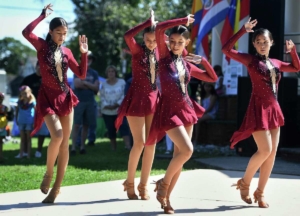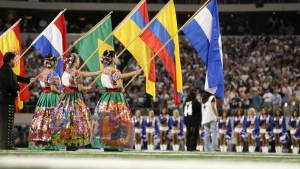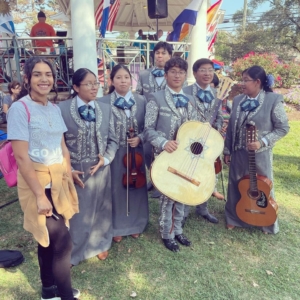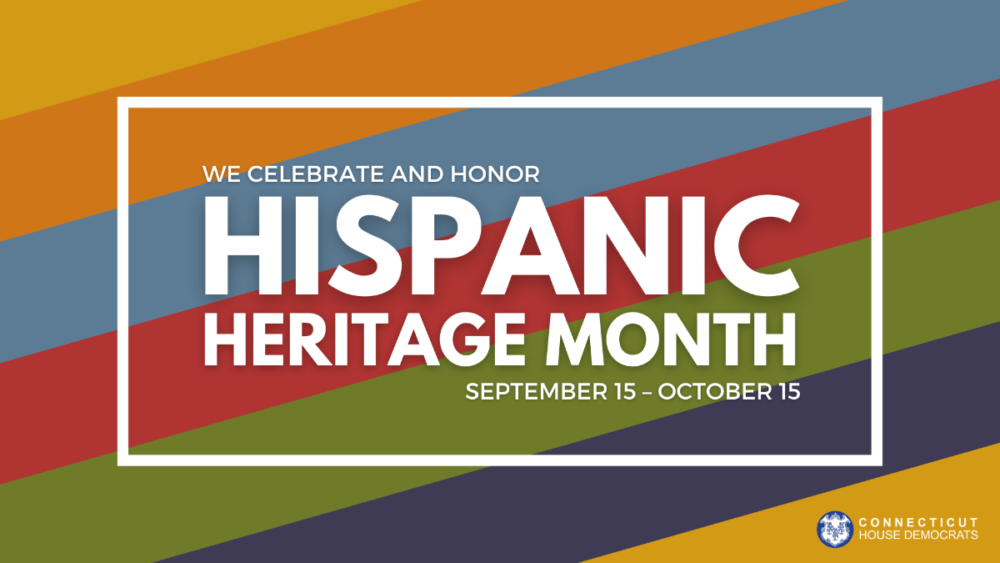September 15th to October 15th
Sources: United States Census Bureau; History.com
 National Hispanic Heritage Month is annually celebrated from September 15th to October 15th in the United States, recognizing the contributions and influence of Hispanic Americans to the history, culture, and achievements for the United States. The U.S. Office of Management and Budget (OMB) defines “Hispanic or Latino” as a person of Cuban, Mexican, Puerto Rican, South or Central American, or other Spanish culture or origin regardless of race.
National Hispanic Heritage Month is annually celebrated from September 15th to October 15th in the United States, recognizing the contributions and influence of Hispanic Americans to the history, culture, and achievements for the United States. The U.S. Office of Management and Budget (OMB) defines “Hispanic or Latino” as a person of Cuban, Mexican, Puerto Rican, South or Central American, or other Spanish culture or origin regardless of race.
The term Hispanic or Latino (or the more recent term Latinx) refers to a person’s culture or origin—regardless of race. On the 2020 Census form, people were counted as Hispanic or Latino or Spanish if they could identify as having Mexican, Mexican American, Chicano, Puerto Rican, Cuban, or “another Hispanic, Latino, or Spanish origin.”
Hispanic Heritage Month always starts on September 15th, a historically significant day marking the independence of five Latin American countries: Costa Rica, El Salvador, Guatemala, Honduras, and Nicaragua. The designated period is also a nod to those from Mexico and Chile, which celebrate their independence September 16th and September 18th, respectively.
Hispanic Heritage Month celebrates the culture and contributions of Americans tracing their roots to Spain, Mexico, Central America, South America, and the Spanish-speaking nations of the Caribbean. The observance was born in 1968 when Congress authorized the president to issue an annual proclamation designating National Hispanic Heritage Week. Two decades later, lawmakers expanded it to a month-long celebration, stretching from September 15th to October 15th.
Facts for Hispanic Heritage Month
- 8% of Hispanics age 25 and over had a college degree in 2020.
- Over half of Hispanics in the U.S. live in California, Texas, or Florida.
- In 2020, the Hispanic population made up the largest racial or ethnic group in New Mexico (47.7%) and California (39.4%).
- In 2019, approximately 6% or 347,000 businesses in the U.S. were Hispanic-owned.

Did you know?
People of Hispanic origin are the nation’s second largest racial or ethnic group. The Hispanic population grew 2.4 percentage points over the decade from 16.3% in 2010 to 18.7% in 2020.
62.6 million: The Hispanic population of the United States as of July 1, 2021, making people of Hispanic origin the nation’s largest racial or ethnic minority — 18.9% of the total population.
13: The number of states with a population of one million or more Hispanic residents in 2021 — Arizona, California, Colorado, Florida, Georgia, Illinois, New Jersey, New Mexico, New York, North Carolina, Pennsylvania, Texas, and Washington.
34,289: The increase (from July 1, 2020 to July 1, 2021) in the number of Hispanics in Riverside County, California, the county with the nation’s greatest growth in this population during this period. Source: County Population by Characteristics: 2020-2021 (census.gov)
30.5: The median age of the Hispanic population, up from 30.2 in 2020.
Source: National Population by Characteristics: 2020-2021 (census.gov)
More Stats
American Hispanic/Latino history is rich, diverse and long, with immigrants, refugees and Spanish-speaking or Indigenous people living in the United States long before the nation was established, bringing with them traditions and culture from Mexico, Spain, Cuba, Puerto Rico, the Dominican Republic and other Latin American and Iberian nations.
From early Spanish colonialism to civil and worker rights laws to famous firsts to recent Supreme Court decisions on immigration, here’s a timeline of notable events in U.S. Hispanic and Latino history.
Early Spanish Explorers Reach America: April 2, 1513. Searching for the “Fountain of Youth,” Spanish explorer Juan Ponce de Leon lands along the Florida coast, claiming the territory in the name of the Spanish crown. He would return in 1521 to establish a colony, but his party, attacked by Native Americans, were forced to retreat to Cuba, where he died.
Sept. 8, 1565. Spanish admiral and explorer Pedro Menendez de Aviles lands at what will become the settlement of St. Augustine, Florida, near the spot Ponce de Leon reached 52 years earlier. Now the oldest continually inhabited American city, St. Augustine was under Spanish rule for 256 years, and British rule for 20 years and served as a Civil War battle site.
1609-1610: Conquistador Don Pedro de Peralta settles Santa, Fe New Mexico, making it the oldest capital city in North America, the oldest European community west of the Mississippi River and the first foreign capital captured by the United States, in 1846, during the Mexican-American War. The original capital of New Mexico had been established by Don Juan de Onate in 1598 at San Juan Pueblo, but it was moved to Santa Fe in 1610.
May 1, 1718: Spanish priest Father Antonio Olivares founds the Mission San Antonio de Valero, better known as The Alamo, the first mission in San Antonio, Texas. Formed to convert Native Americans to Christianity, it became a fort and site of rebellion in 1835.
Battle of the Alamo, Mexican-American War March 6, 1836: After 13 days of siege, Mexico President and General Antonio Lopez Santa Anna, with 1,000-plus Mexican soldiers, storm the Alamo, killing most of the Texan soldiers inside, who include now-famous heroes Davy Crockett, James Bowie and Lt. Col. William Travis, even those who had surrendered. “Remember the Alamo!” becomes a battle cry for the Texas militia, which eventually wins independence. In 1845, Texas is annexed by the United States.
1846-1848
The Mexican-American War takes place, following a dispute over border control following America’s annexation of Texas. The Treaty of Guadalupe Hidalgo ends the war, setting a border at the Rio Grande River between Texas and Mexico, and also giving America control of California, New Mexico, Nevada, Utah, a majority of Colorado and Arizona and part of Oklahoma, Wyoming and Kansas.
July 9, 1868
The Fourteenth Amendment to the U.S. Constitution is adopted. Section 1 states that “all persons born or naturalized in the United States, and subject to the jurisdiction thereof, are citizens of the United States and of the State wherein they reside.”
April 21, 1898
The U.S. declares war against Spain, with major campaigns fought in Cuba and the Philippines. The Spanish-American War, which ends December 10, 1898 with the Treaty of Paris, marks the end of Spain’s colonial power, with the country granting Cuba independence and ceding Guam, Puerto Rico and the Phillipines to the United States. Hawaii is also annexed during the war.
1910-1917
The long and violent Mexican Revolution causes a surge of Mexicans to cross the U.S. border, with El Paso, Texas, serving as “Mexican Ellis Island,” according to the Library of Congress. The U.S. census finds Mexican immigrants to have tripled in population between 1910 and 1930, from 200,000 to 600,000.
Feb. 5, 1917
Congress overrides a veto by President Woodrow Wilson to pass the Immigration Act of 1917, the first sweeping legislation to limit immigration in America. Also referred to as the Asiatic Barred Zone Act and the Literacy Act, it bans immigrants from most Asian countries. It also includes a literacy test for all immigrants older than 16, requiring them to read English or another listed language for entry, and bars convicted criminals, alcoholics, anarchists, those with contagious diseases and epileptics.
Puerto Ricans Granted US Citizenship: March 2, 1917
President Wilson signs the Jones-Shafroth Act, granting U.S. citizenship to Puerto Ricans and creating a bicameral legislature in the island territory. With the United States about to enter World War I, it also gives America a stronghold and allows Puerto Ricans to join the U.S. Army. Eventually, 20,000 Puerto Ricans are drafted to serve during the conflict, many charged with guarding the important Panama Canal.
May 28, 1924
Congress creates the Border Patrol, part of the Department of Labor’s Immigration Bureau, as established in the Labor Appropriation Act of 1924. In 1925, its patrol areas include the seacoast, and later, in 1932, it is divided with one director in charge of the Canadian border, and one in charge of the Mexico border.
Dec. 7, 1928
Octaviano Ambrosio Larrazolo of New Mexico is sworn in as the country’s first Hispanic senator. The Republican attorney, born in Mexico, immigrated to the United States when he was a boy. He served one term as governor of New Mexico and later was elected twice to the state House of Representatives before running for the U.S. Senate. But his time in Washington didn’t last long: In January he fell gravely ill and returned to New Mexico where he died April 7, 1930.
Dec. 7, 1941
Japan attacks Pearl Harbor, drawing the U.S. into World War II. More than 500,000 Mexican Americans serve in the American military during the conflict, with 13 Medals of Honor awarded to Latinos. The 158th Regimental Combat Team, largely composed of Latino and Native American soldiers who fought in the Philippines and New Guinea, is called “the greatest fighting combat team ever deployed in battle” by Gen. Douglas MacArthur.
Aug. 4, 1942
The U.S. and Mexico sign the Mexican Farm Labor Agreement, called the Bracero Program, America’s biggest guest-worker program created to avoid labor shortages during the war that would go on to last more than two decades until 1964. The controversial program allows manual workers (braceros) from Mexico to work in the United States short-term, mostly in agriculture, with basic protections, such as a minimum wage, insurance and free housing, although employers did not ignore those standards.
April 14, 1947
The 9th Circuit Court of Appeals makes a landmark ruling prohibiting segregation in California public schools in Mendez v. Westminster School District. In the case, the family of Sylvia Mendez, then 9, and others sued four school districts for being denied entrance to Westminster Elementary School because they were Mexican. The ruling sets precedent for the historic Brown v. Board of Education Supreme Court case seven years later.
June 9, 1954
President Dwight D. Eisenhower institutes “Operation Wetback,” a controversial mass deportation using a racial slur, in which the government rounds up more than 1 million people. Blaming illegal immigrants for low wages, the raids start in California and Arizona, and, according to a publication in the U.S. House of Representatives archives, disrupt agriculture. Funding runs out after a few months, bringing the operation to an end.
April 17, 1961
U.S.-trained Cuban exiles invade their homeland during the botched Bay of Pigs in a failed attempt to overthrow Dictator Fidel Castro. Soon after his inauguration, President John. F. Kennedy authorizes the plan. When the 1,400 exiles land at the Bay of Pigs on Cuba’s southern coast, they come under a swift counterattack by 20,000 Cuban troops and the invasion ends April 19, with nearly all of the exiles surrendering and 100 dead. Two months later, the prisoners begin to be released in exchange for $53 million worth of medicine and baby food.
July 2, 1964
The landmark Civil Rights Act of 1964 becomes law, signed by President Lyndon B. Johnson, and outlawing discrimination based on race, sex, religion, color or national origin. The act also creates the Equal Employment Opportunity Commission to enforce federal job discrimination laws. One immediate effect of the act: an end to segregated facilities requiring Black Americans and Mexican-Americans to use only designated areas.
Oct. 3, 1965
President Johnson signs the landmark Immigration and Nationality Act of 1965, better known as the Hart-Celler Act, into law, an immigration reform bill that ends a quota system established in 1924 based on country of origin (70 percent of immigrants were to go to Northern Europeans). The act gives priority to highly skilled immigrants and those with family already living in America. Post Hart-Celler, nearly 500,000 people immigrate annually, with 80 percent coming from countries other than Europe.
March 17, 1966
Cesar Chavez, general director of the National Farm Workers Association, leads 75 Latino and Filipino farm workers on a historic 340-mile march from Delano, California to the state capitol in Sacramento. Drawing attention to the demands of grape growers, the march, held at the onset of a strike that would last five years, lasts 25 days, and upon arrival in Sacramento on Easter Sunday, the group is met by a crowd of 10,000. Later that summer, the NFWA merges with the Agricultural Workers Organizing Committee to form the United Farm Workers union that affiliates with the AFL-CIO.
April 16, 1973
The Dade County Commission unanimously passes a resolution from Miami’s mayor making Spanish the city’s second official language and creating a department of bilingual and bicultural affairs. In 1974, the Florida city is home to 350,000 Cubans who have been fleeing the country under Fidel Castro’s regime for more than 15 years. On November 8, 1973, Maurice A. Ferré is elected Miami’s first Hispanic mayor, also becoming the first Puerto Rican to lead a major U.S. mainland city.
March 20, 1973
Puerto Rican right fielder Roberto Clemente is inducted into the National Baseball Hall of Fame 11 weeks after he was killed in a small plane crash while traveling from Puerto Rico to Nicaragua to assist in earthquake relief efforts. The owner of four National League batting titles, he received 12 straight Golden Glove awards, was the 1966 NL MVP, and, in 1971 at age 37, led his Pittsburgh Pirates to a World Series victory, earning the MVP title. Voted into the hall in a special election, he is the first Latin-American baseball player admitted.
Aug. 6, 1975
President Gerald Ford extends the Voting Rights Act of 1965, with the amended Section 203 mandating that bilingual ballots be provided in certain areas.
April 20, 1980
Fidel Castro announces that Cuban citizens may immigrate to Florida from the port of Mariel with their own arranged boat transport. In the months that follow, 125,000 Cubans flee the country, in what came to be called the Mariel Boatlift. Many of the immigrants were law-abiding citizens and families, but others, called “marielitos” were prisoners, criminals and the mentally ill sent by Castro, causing President Jimmy Carter political woes.
Nov. 6, 1986
President Ronald Reagan signs the Immigration Reform and Control Act into law, granting 2.7 million long-term immigrants permanent legal status, but also imposing restrictions, increasing border security and making it illegal for employers to knowingly hire unauthorized workers.
Sept. 21, 1988
Dr. Lauro Cavazos, a Texan, is sworn in by Vice President George H.W. Bush as secretary of education, making him the first Hispanic to serve in a presidential cabinet.
Aug. 29, 1989
Cuban immigrant Ileana Ros-Lehtinen is the first Hispanic woman elected to Congress, later becoming the first woman to chair the House Foreign Affairs Committee. Over 30 years—15 terms—the Republican from Miami served in the Florida House and Senate before representing the state’s 110th District. In 1990, Dr. Antonia Novello is appointed the first women and first Hispanic U.S. surgeon general under Bush, and, in 1993 Ellen Ochoa becomes the first Hispanic woman to travel to outer space.
Jan. 22, 1993:
Federico Pena, who previously served as Denver’s first Hispanic mayor, is confirmed by the Senate as U.S. Secretary of Transportation under the nomination of President Bill Clinton, making him the first Hispanic to hold the position. He also spends two years as the first Hispanic Secretary of Energy under Clinton, immediately followed in that role by another Hispanic, former New Mexico Gov. Bill Richardson.
Jan. 1, 1994
The North American Free Trade Agreement (NAFTA) between the U.S., Mexico and Canada takes effect, establishing a North American trade-free zone and lifting tariffs of most goods. It is replaced, in 2020, by the US-Mexico-Canada Agreement.
Nov. 8, 1994
Proposition 187, called “Save Our State,” is passed in California, a controversial ballot measure requiring law enforcement, teachers and health care professionals to verify and report the immigration status of all individuals, in an effort to “prevent illegal aliens in the United States from receiving benefits or public services in the State of California.” Lawsuits and challenges are immediately filed, with a U.S. District Court judge issuing temporary restraining order just days later and another District Court judge declaring most of it unconstitutional in 1998.
Jan. 22, 2003
The U.S. Census Bureau releases statistics showing Hispanics are the country’s largest minority group, with a population of 37 million, while the Black population stands at 36.2 million.
Aug. 8, 2009
Sonia Sotomayor is sworn in by Chief Justice John Roberts as the first Hispanic Supreme Court justice and the third woman to serve on the court. Raised in a housing project in the South Bronx, N.Y., she is the daughter of Puerto Rican parents and previously served on the board of directors for the Puerto Rican Legal Defense and Education Fund.
June 25, 2012
In a 5-3 ruling, the U.S. Supreme Court strikes down most of SB1070, an Arizona immigration law in Arizona v. United States. The decision finds three of the four provisions of the statute are preempted by federal law: the section making it a crime to reside in the country illegally, the section making it unlawful for undocumented workers to apply for a job and the section allowing warrantless arrest based on probable cause of unlawful presence. However, the court does uphold the law’s requirement that law enforcement officers verify immigration status during lawful stops.
June 23, 2016
In a one-sentence ruling, the U.S. Supreme Court announces it is equally divided in a case involving a lower court’s decision to block President Barack Obama’s 2014 executive immigration order, Deferred Action for Parents of Americans and Lawful Permanent Residents (DAPA), granting deportation relief to 4 million-plus undocumented people living in the U.S. providing they pay taxes, pass background checks and reside in the country for more than five years.
June 18, 2020
In a 5-4 ruling, the U.S. Supreme Court blocks an attempt by the Trump administration to end the Deferred Action for Childhood Arrivals (DACA) program protecting immigrants who came to the country as children from being deported. Established in 2012 under President Obama, DACA protects 700,000 “Dreamers.”
 The Stratford Hispanic Heritage Committee
The Stratford Hispanic Heritage Committee
The Stratford Hispanic Heritage Committee started promoting the pride of Hispanic heritage in Stratford in 2005 as part of National Heritage Month to increase cultural sensitivity, foster understanding, and celebrate the literacy, music, and the artistic expression Hispanic cultures.
One of the committee’s primary goals is to provide scholarships for qualified students of Hispanic Heritage to attend college. Since 2009 the committee has awarded approximately $70,000 to students attending Bunnell and Stratford High School.
Their main fundraising event for the scholarship program is their annual Scholarship Gala. This year’s event will take place on October 8th at the Trumbull Marriott Hotel on Hawley Lane in Trumbull. Dance the night away from 7 p.m.- 11 p.m., enjoy dinner with a Latin flare.
For tickets contact Olga Pena, 203-820-3658. Presale 2 tickets for $150, at the door $95 earch.



We have data about the number of people of Spanish heritage there are in this country. I would like to know if there’s data about what percentage of Hispanics vote in all elections.